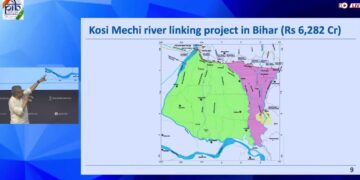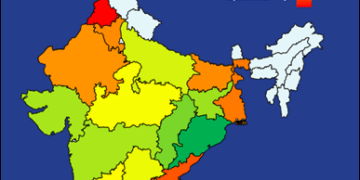A significant political controversy is unfolding in India, with particular intensity in the southern region. Political leaders from southern states are rallying citizens to protect their electoral interests amidst concerns over the impending delimitation process, which would redraw constituency boundaries based on population changes.
Tamil Nadu’s Chief Minister MK Stalin, a prominent opponent of Prime Minister Narendra Modi’s BJP, has described delimitation as “a Damocles’ sword hanging over southern India”. This concern extends across all five southern states—Tamil Nadu, Andhra Pradesh, Karnataka, Kerala, and Telangana—which collectively represent 20% of India’s 1.4 billion population and boast superior performance in health, education, and economic indicators compared to northern regions.
The crux of the southern states’ anxiety lies in the possibility of losing parliamentary representation due to their successful population control measures and economic prosperity. These states have historically contributed more to federal revenue, while densely populated, economically disadvantaged northern states receive larger allocations based on need.
India’s Constitution stipulates that parliamentary seats should be allocated proportionally to population, with constituencies of roughly equal size. Historically, India redrew parliamentary boundaries three times following the censuses of 1951, 1961, and 1971. However, subsequent governments have suspended this exercise, fearing representational imbalances resulting from varying fertility rates across states.
The next delimitation is scheduled for 2026, but uncertainty prevails as India has not conducted a census since 2011, with no definitive timeline established for the next one. This situation has created conditions for a potential constitutional crisis, with Tamil Nadu leading opposition to the process.
Currently, the Lok Sabha (lower house of parliament) comprises 543 directly elected MPs, a figure unchanged since the 1970s despite significant population growth. In 1951, each MP represented approximately 700,000 citizens; today, that figure has surged to 2.5 million—more than triple the representation ratio in the US House of Representatives and over 20 times that of UK parliamentarians.
Economist Shruti Rajagopalan has highlighted the “severe malapportionment” in India’s electoral system. For instance, in Uttar Pradesh (UP), India’s most populous state with over 240 million inhabitants, each MP represents approximately three million citizens. Conversely, in Kerala, where fertility rates mirror European levels, an MP represents roughly 1.75 million people. Consequently, a Kerala voter wields 1.7 times more electoral influence than a voter in UP.
Tamil Nadu and Kerala currently have nine and six seats more than their population proportion would warrant, while Bihar and UP have nine and twelve seats fewer than their proportional entitlement. Stalin warns that Tamil Nadu could lose eight seats following the 2026 delimitation based on projected population figures.
By 2031, this disparity will intensify further: UP and Bihar will be short approximately twelve seats based on their population share, while Tamil Nadu will likely have eleven seats more than its proportional allocation.
Proposed Solutions
Experts have suggested several remedies requiring strong bipartisan consensus:
- Expand the Lok Sabha: Revert to the original constitutional ratio of one MP per 750,000 citizens, which would increase the chamber to 1,872 seats. However, the new parliament building has capacity for only 880 members, necessitating significant expansion.
- Moderate Expansion: Increase the Lok Sabha to 848 seats, ensuring no state loses its current representation.
- Fiscal Decentralisation: Grant states greater revenue-raising powers, allowing them to retain most or all locally generated revenue. Federal funds would then be allocated based on development requirements rather than population. Currently, states receive less than 40% of total revenue despite being responsible for 60% of expenditure.
- Reform the Rajya Sabha: Transform the upper house into a more equitable forum by fixing the number of seats per state, similar to the US Senate model, potentially mitigating opposition to lower house reallocation.
- State Division: Split large states like Uttar Pradesh, which currently commands approximately 14% of India’s total votes and would likely increase to 16% after delimitation.
Southern leaders, joined by counterparts in Punjab, have urged the government to maintain current seat allocations and freeze electoral boundaries for 30 years beyond 2026. The BJP government has made limited statements on the issue, with Home Minister Amit Shah claiming southern states would not lose “even a single seat” in the upcoming delimitation, though the precise meaning remains ambiguous.
Political scientist Suhas Palshikar warns that the north-south divide threatens India’s federal structure, potentially triggering counter-mobilisation in northern states that would complicate any negotiated settlement. He advocates expanding the Lok Sabha while ensuring no state loses its current representation, describing this approach as both “politically prudent” and beneficial for Indian democracy.
Summary of Key Points
- Constitutional Tension: India faces a significant federal challenge regarding the redistribution of parliamentary seats through delimitation scheduled for 2026, creating tension between northern and southern states.
- Demographic Divergence: Southern states with lower fertility rates and higher economic development fear losing political representation to more populous northern states, perceiving this as punishment for successful population control and economic progress.
- Representational Imbalance: Currently, significant malapportionment exists—MPs from Uttar Pradesh represent approximately three million citizens each, while those from Kerala represent about 1.75 million, creating unequal voter influence across regions.
- Constitutional Mandate: India’s Constitution requires constituencies of roughly equal population size, but delimitation has been frozen since 1971, creating growing disparities as population patterns have shifted dramatically.
- Proposed Solutions: Experts suggest expanding the Lok Sabha from 543 to between 848-1,872 seats, reforming the Rajya Sabha, implementing fiscal decentralisation, or dividing large states to address representational imbalances.
- Political Implications: The issue threatens India’s federal structure, with potential for heightened north-south divisions if not addressed through negotiated settlement and balanced representation.


















